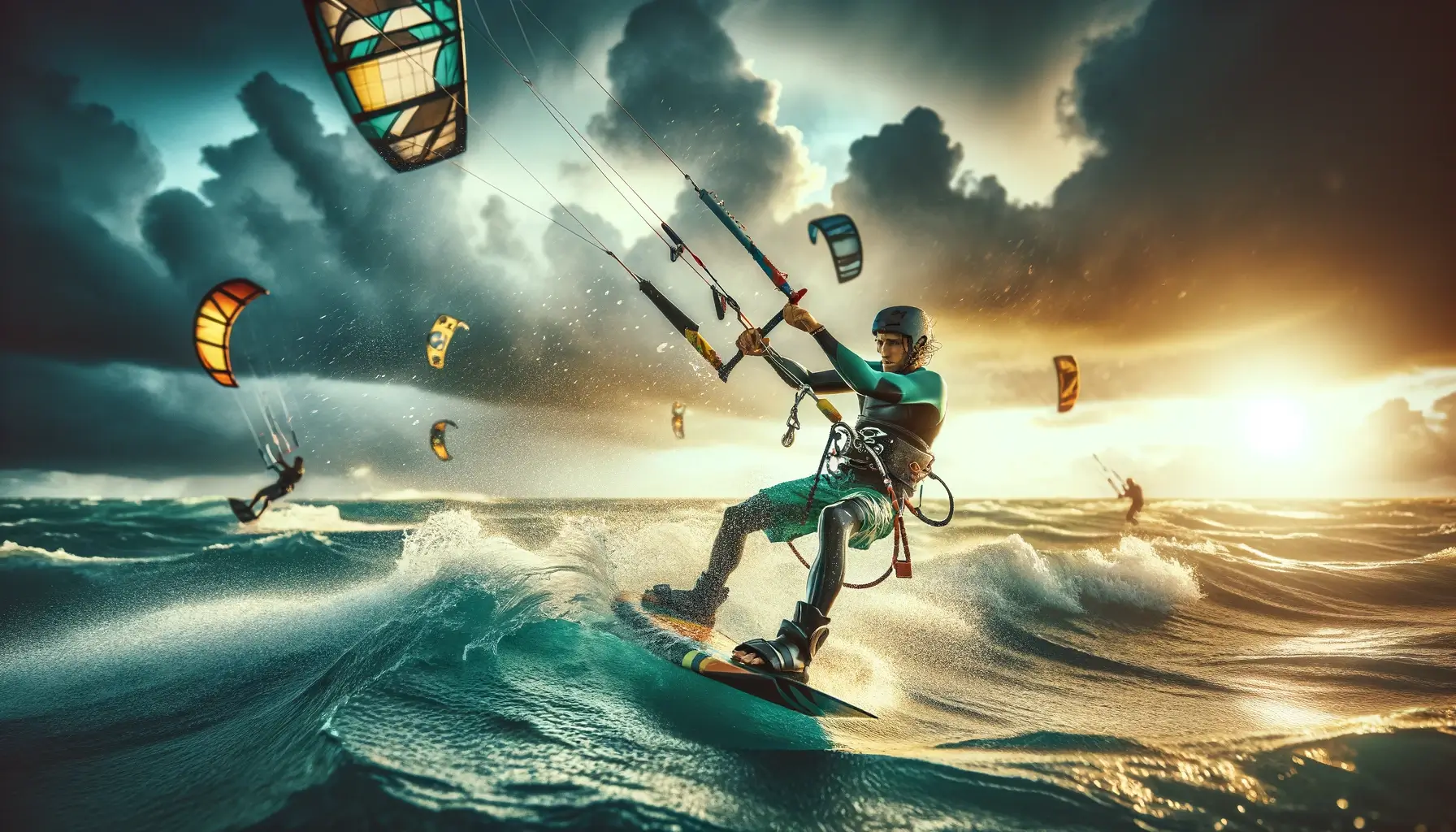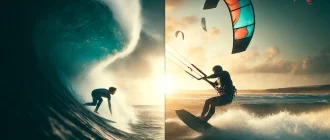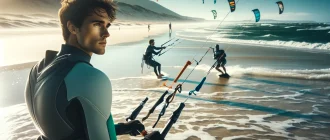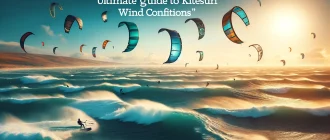Is kitesurfing hard? For beginners embarking on this exciting journey, it combines challenging elements of technique and physicality.
While it’s not a walk in the park, mastering the waves is within reach with the right approach and mindset.
Our guide breaks down the initial hurdles, ensuring you feel confident to step into the breeze with the essential knowledge to conquer your first ride on the learning curve.
Key Takeaways
- Kitesurfing is inclusive and considered safe with the proper instruction and equipment. It requires a balance of technical and physical skills, starting with kite control.
- Progressing in kitesurf involves mastering kite control, riding techniques, and riding up and downwind. It emphasizes consistent practice and equipment familiarity.
- Proper instruction from certified kitesurfing schools and the choice of suitable gear tailored to the beginner’s needs are crucial for a safe and successful kitesurf experience.
Debunking Common Kitesurfing Misconceptions

Firstly, let’s dispel some myths. Kitesurf is not a sport exclusive to men; it is inclusive and suitable for all genders. Seeing a kitesurfer soaring above the waves might seem daunting, but the fears of danger are often based on misconceptions.
Like any sport, kitesurfing is considered safe when practicing with proper safety measures. With the correct instruction and equipment, beginners can quickly balance thrill and safety.
The Learning Curve: Breaking Down the Kitesurf Process

Mastering kitesurf requires a mix of technical learning and physical fitness. The pivotal point to learn kiteboarding part of this learning process is understanding the kitesurfing instruction and basics of kiteboarding and control, which typically has extra lessons and takes 1 to 3 hours. However, the challenge of learning kiteboarding started kitesurfing itself, and it doesn’t stop there.
Kitesurfing is a multifaceted sport. It balances physical and technical demands, with the kite’s power channeled through a harness rather than relying on brute strength. This combination of components in kiteboarding also contributes to its overall complexity and the learning challenge for beginners.
Kite Control Mastery
Gaining proficiency in kite control forms the base of your journey to learn kitesurf. Practicing with a trainer kite is fundamental to honing kite flying skills without the added complexity of board kiting.
This smaller and more manageable kitesurfing board will help new kitesurfers control the bar and prevent line tangling, ensuring a smoother learning curve and experience with the latest kit.
Experienced instructors stress kite control as the most critical skill for novices, underscoring the importance of trainer kites in the learning process.
This practice can help develop relaxed and intuitive control over the bigger kite without using a control bar, reducing tension and fear of bigger kites and boosting overall confidence in kite handling students riding.
Riding Techniques
After gaining proficiency in kite control, board riding becomes the next hurdle. This aspect of kitesurfing requires coordination, balance, and kite control, overshadowing the need for raw muscular strength.
Achieving balance among the forces of gravity to control the kite, pull, control bar, and kiteboard kick is essential for a successful board bigger than kite flying and riding in kitesurf.
Additionally, twin-tip boards, commonly used in kitesurfing, lack helmets, and buoyancy aids, so riders must gain speed to the plane in very shallow water while wearing a helmet and buoyancy aid for safety.
Riding Upwind and Downwind
After mastering kite flying and board riding, the next important aspect of kiteboarding to tackle is riding upwind and downwind.
Kiting upwind is achievable through consistent practice, maintaining a suitable speed, the correct kite position, and optimal body positioning.
Advanced techniques for riding upwind include managing the board’s tilt and foot pressure and mastering maneuvers that ride upwind, like edging and tacking.
Downwind riding presents challenges, such as keeping kite lines tensioned to prevent loss of power and control, while kiting upwind requires different techniques within the wind window.
Importance of Proper Instruction and Equipment
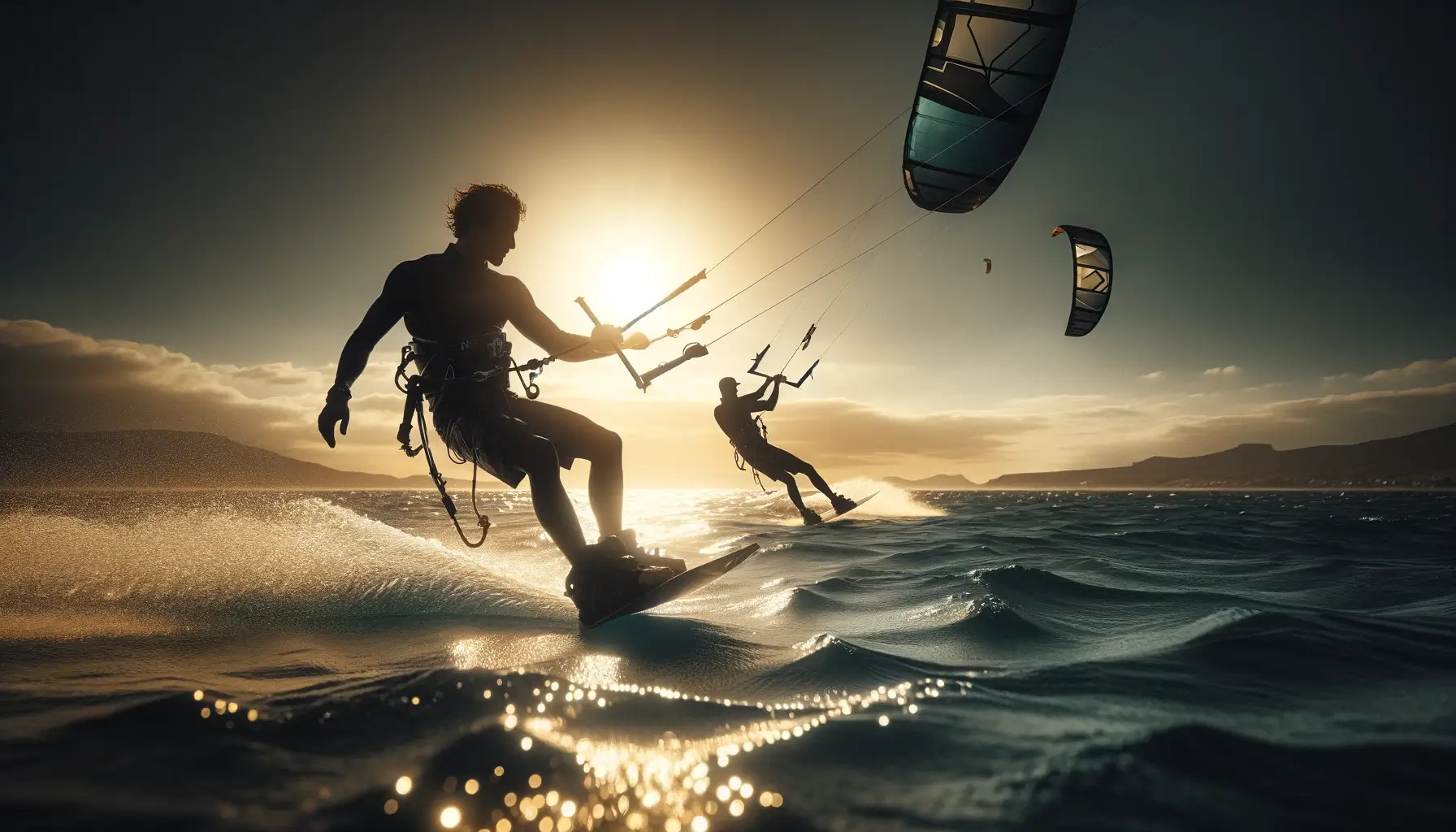
Sound kitesurf instruction and quality gear form the backbone of a safe and successful kitesurf journey. Choosing a kitesurf school with certified instructors from recognized organizations ensures a secure and efficient learning experience.
To prevent your own kitesurfing equipment, kite, and equipment from failure, the quality of your kitesurf gear and safety systems used gear, including harnesses and depower lines, must be regularly inspected for damage.
Trainer kitesurf schools are also essential for beginners to practice safe crashing techniques, a crucial part of learning to control a kite. Preparing for emergencies, like lines tangling or tool failure, is vital for kitesurfing safety.
Finding the Right Kitesurfing Instructor
Opting for a reputable kitesurf school with passionate and experienced instructors can significantly enhance the learning experience for beginners.
It’s essential to ensure a new equipment prospective certified kitesurf instructor has proper certification and to inquire the certified instructor about their teaching experience and personal kitesurfing journey to verify their passion and qualifications for providing kitesurf lessons in local conditions.
Effective learning involves communicating fears to the instructor, allowing them to tailor lessons to the student’s comfort level and create a positive experience.
Choosing Suitable Kitesurfing Gear
Appropriate gear can significantly influence your kitesurfing journey. Here are some tips to consider:
- Beginners should select a well-fitting harness, a key piece of equipment, and reasonably priced to allow for future upgrades if necessary.
- It’s safer for beginners to use straps as they reduce the risk of injury during falls.
- Using a consistent brand for kites and bars can ensure optimal flying characteristics as they are designed to work best together.
The choice of kiteboard and kite size should be based on the rider’s weight and height and the typical wind conditions of the kitesurf location.
Investing in quality gear appropriate for a beginner’s level is crucial, and it is strongly recommended that you avoid using outdated or in poor condition gear.
Overcoming Challenges in Kitesurf
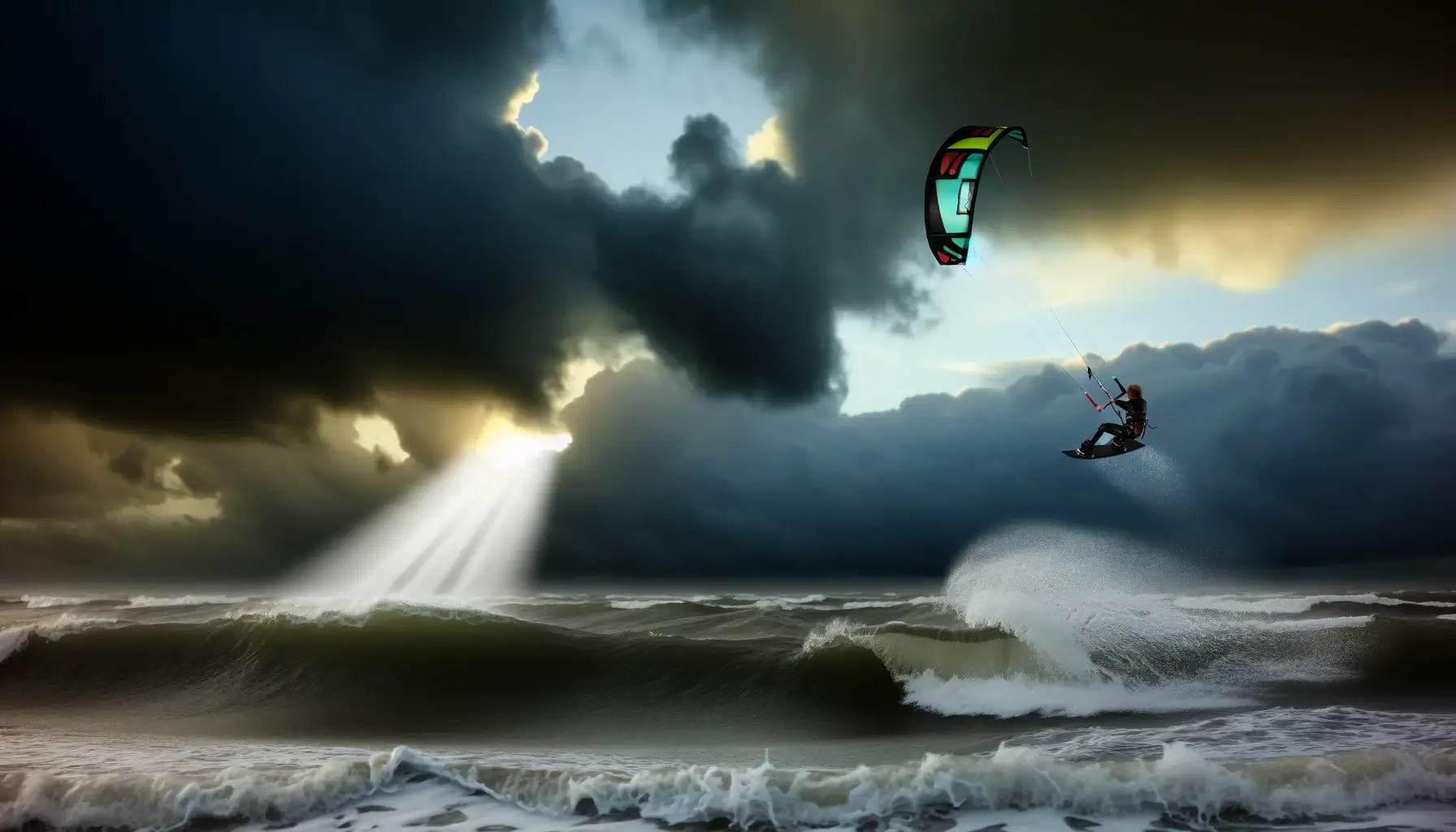
Kitesurfing is a versatile sport. Individuals of different fitness levels can enjoy it, and with proper technique, physical fitness is not a barrier. Over time, kitesurf serves not just as a dangerous sport but also as a means to:
- Improve cardiovascular endurance
- Strengthen core muscles
- Enhance balance and coordination
- Increase flexibility and agility
So, whether you’re a beginner or an experienced kitesurfer, the sport’s physical fitness aspects can benefit you.
But the journey doesn’t stop there. Mastering upwind kiting is essential in kitesurfing, making small kiteboarding easy. Surfers with traction kites make kitesurfing easy to stay within the same area and avoid having to walk back to the beach.
Wind and Weather Conditions
Comprehending wind conditions is a vital part of mastering kitesurfing. Typically, 12 mph of wind is required for the average kiteboarder to ride, although this can vary depending on the rider’s weight.
Wind power increases exponentially with wind speed, so smaller kites in high winds move much faster than larger kites in light winds.
For safety, new kiteboarders should steer clear of solid weather systems, including thunderstorms with gusty winds.
They should not be learning to kitesurf in busy areas or offshore or onshore in strong winds without the basic skills of kiting upwind or without a chase boat.
Understanding weather patterns and having versatile gear can double a kiteboarder’s time on the water.
Progression Plateaus
Like any sport, kitesurf has progression plateaus. By adding new elements like grabs to tricks and switching to different boards, such as a strapless surfboard, kitesurfers can introduce fresh challenges to overcome these plateaus.
Practicing on their non-dominant side can enhance their overall skills and avoid hitting a plateau in their progression.
Keeping motivation high is critical when facing a plateau, but maintaining balance and diversifying the tricks practiced can help maintain enjoyment in the sport’s learning phase.
Mental Hurdles
Kitesurfing involves as much mental effort as it does physical effort. Accepting that difficulties can happen is an essential cognitive skill in kitesurfing.
Adapting to setbacks with an “oh well” attitude helps shift focus from frustration to positive alternatives, enhancing the kitesurfing experience.
Believing in oneself and having a solid determination to succeed are vital motivators for conquering the mental challenges kitesurf beginners face.
Kitesurfers can achieve post-traumatic growth by:
- Learning from their mistakes
- Making plans to avoid repeating them
- Facing fears
- Embracing new experiences in kitesurfing
These two sports and actions contribute to the same thrill and personal growth direction in the extreme sport, pushing participants into their own gear and power zone.
How Kitesurf Compares to Other Board Sports
Kitesurfing is a hybrid sport similar to other board sports, such as wakeboarding and snowboarding. Practicing wakeboarding can improve one’s edging and popping skills, which are directly applicable to kitesurf.
Learning to carve on a snowboard helps one understand edge control in the dangerous and extreme sport of kitesurfing. Kiteboarding is a great way to enhance one’s skills in this exciting sport.
Kitesurfing, however, has unique aspects, such as the harness system and reliance on wind. The environmental conditions for optimal wakeboarding, for example, calm and glassy water, differ significantly from those for kitesurfing, which requires sufficient wind.
Safety Measures for Beginner Kitesurfers
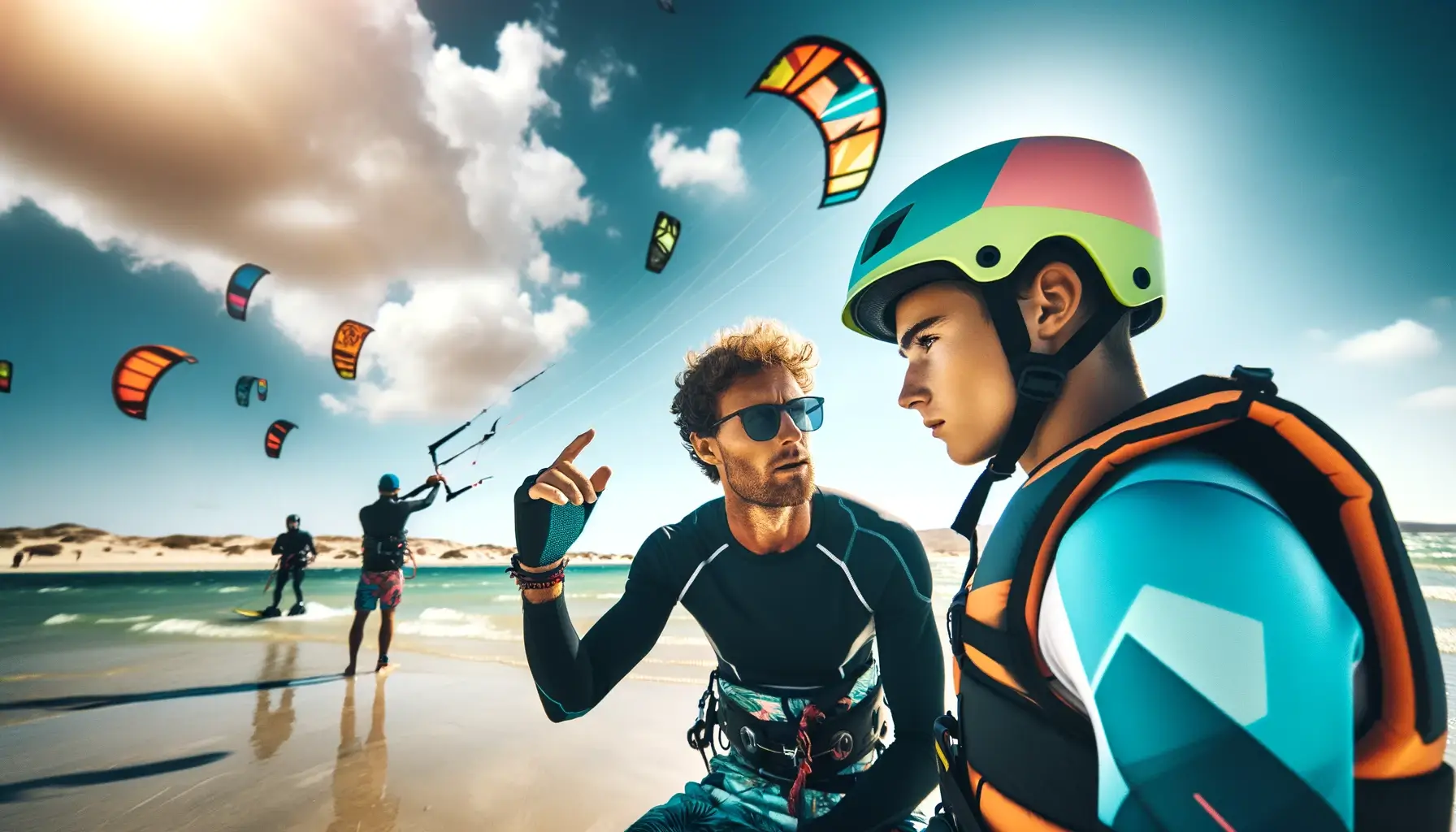
Safety is of the utmost importance for beginners in kitesurf. Investing in modern kitesurf gear, including complete depower capabilities and easy-to-activate quick-release systems, enhances safety.
Familiarize yourself with the kite’s chicken loop release safety system that ensures quick emergency response.
It’s also crucial to learn and master self-rescue techniques, including emergency landing, to handle unexpected situations on the water confidently. Maintain physical fitness, avoid kitesurf when tired or under the influence of alcohol, and stop if feeling unwell.
Overview
Kitesurf is an exhilarating sport that blends technical learning and physical fitness. Although it may seem challenging initially, with the correct instruction, gear, and mental attitude, the journey from beginner to bliss is entirely achievable.
So step into the wind window with new gear, into the harness, ride small kites upwind again, feel the power zone, the kite’s pull, and the good wind, and prepare to ride upwind on the leading edge of the waves. The breeze awaits.
Frequently Asked Questions
Can you kite surf as a beginner?
Yes, you can kitesurf as a beginner, but it’s crucial to take beginner kitesurfing lessons and choose the right type of kite to make learning to kitesurf more accessible.
Learning the proper techniques and safety procedures to start kitesurfing from a good instructor is essential for a smooth start to kitesurfing.
Do you have to be strong to kitesurf?
You don’t have to be very strong to kitesurf, but being physically fit and having good core strength can be beneficial. Kitesurf and other sports often rely more on coordination, balance, and body control than sheer body strength.
How hard is it to get into kitesurf?
Kitesurfing can be challenging for beginners due to the mastery of various skills, such as kite and board control. Still, with proper training and practice, many people can learn and enjoy kitesurf.
Is kitesurf suitable for all genders?
Yes, kitesurfing is a sport that is suitable for all genders.
How long does it take to learn essential kite control in kitesurf?
In your first lesson on learning to learn kitesurfing yourself, you usually need 1 to 3 hours to learn kitesurfing and the basics of kite control. Happy kitesurf!

